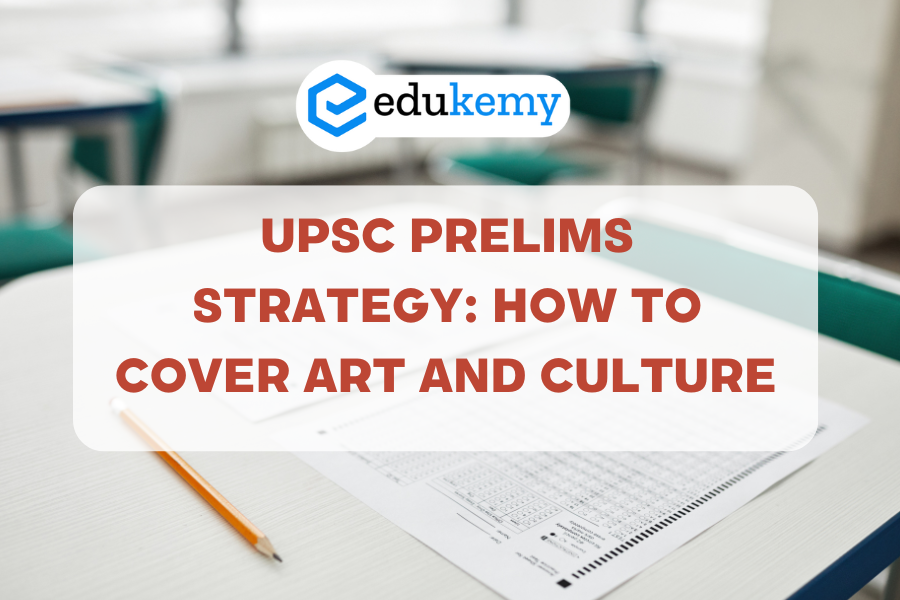Master the Art and Culture segment for UPSC Prelims with a smart prelims strategy. Learn effective tips to cover this vast syllabus in a structured way.

Contents
- 1 Introduction
- 2 Why is Art and Culture Important for UPSC Prelims?
- 3 Understanding the Syllabus
- 4 Sources to Cover Art and Culture
- 5 How to Approach Art and Culture for Prelims
- 6 High-Priority Topics for Prelims
- 7 Common Mistakes to Avoid
- 8 Conclusion
- 9 To get free counseling/support on UPSC preparation from expert mentors please call 9773890604
Introduction
Art and Culture is a crucial segment of the UPSC Prelims syllabus. While it holds significant weight, the subject often feels vast and undefined to aspirants. With limited time and resources, a strategic approach can help you master this section effectively. Here’s a comprehensive guide to covering Art and Culture for UPSC Prelims.
Why is Art and Culture Important for UPSC Prelims?
- High Weightage: Every year, 5-8 questions are asked from Art and Culture, making it an essential section for scoring well.
- Static Nature: Unlike current affairs, this section does not change, making it easier to prepare.
- Interdisciplinary Linkages: Understanding Art and Culture enhances your preparation for History, Polity, and Ethics.
Understanding the Syllabus
The Art and Culture portion of the UPSC syllabus can be broadly divided into:
- Architecture: Covers ancient, medieval, and modern architectural styles, including temples, stupas, mosques, forts, and colonial buildings.
- Paintings: Focus on murals, miniature paintings, and regional art forms like Madhubani, Pattachitra, and Warli.
- Dance Forms: Classical (Bharatanatyam, Kathak, Odissi, etc.) and folk dances.
- Music: Classical music traditions (Hindustani and Carnatic) and regional music styles.
- Sculpture: Ancient sculptures from the Mauryan, Gupta, and Chola periods.
- Literature: Ancient texts like Vedas, Upanishads, Sangam literature, and medieval literature (Bhakti and Sufi traditions).
- Theatre and Drama: Regional and traditional forms like Yakshagana, Nautanki, and Kutiyattam.
- Festivals and Crafts: Religious festivals, regional crafts, and UNESCO-recognized intangible cultural heritage.
Sources to Cover Art and Culture
- NCERT Books:
- Class XI: An Introduction to Indian Art
- Class XII: Themes in Indian History Part I and II
- Standard Books:
- Indian Art and Culture by Nitin Singhania: A comprehensive resource for both Prelims and Mains.
- The Wonder That Was India by A.L. Basham: For historical and cultural insights.
- Government Publications:
- CCRT (Centre for Cultural Resources and Training) website.
- Ministry of Culture annual reports.
- Online Resources:
- PIB updates on cultural events.
- UNESCO website for World Heritage Sites.
- Previous Year Question Papers:
- Analyze trends to understand which topics are frequently asked.
How to Approach Art and Culture for Prelims
- Focus on Themes:
- Avoid rote learning and focus on broader themes like regional variations, influences, and chronology.
- For example, study how Buddhist architecture evolved from stupas to rock-cut caves.
- Make Notes:
- Prepare concise notes with key facts, timelines, and visual aids like flowcharts.
- Highlight important UNESCO-recognized sites, their locations, and unique features.
- Integrate with History:
- Art and Culture is intertwined with Ancient and Medieval History. While studying history, note cultural aspects like architecture, literature, and religion.
- Use Visual Aids:
- Refer to images of sculptures, paintings, and monuments to develop visual memory.
- NCERT books and websites like CCRT are excellent for this purpose.
- Revise Regularly:
- Dedicate time to revise your notes weekly.
- Focus on factual accuracy, as Prelims questions often require precise answers.
- Solve MCQs:
- Practice questions from previous years and mock tests.
- This will help you understand the type and difficulty level of questions.
High-Priority Topics for Prelims
- UNESCO World Heritage Sites:
- Study both cultural and natural heritage sites in India.
- Buddhist and Jain Architecture:
- Stupas, chaityas, and viharas.
- Important sites: Sanchi, Ajanta, and Ellora.
- Temple Architecture:
- Nagara, Dravida, and Vesara styles.
- Examples: Brihadeshwara Temple, Khajuraho Temples, Sun Temple at Konark.
- Classical and Folk Dances:
- Key features, origin, and associated states.
- Indian Paintings:
- Focus on Ajanta murals, Mughal miniatures, and tribal art forms.
- Cultural Influence of Dynasties:
- Mauryan, Gupta, Chola, and Mughal contributions to art and culture.
- Religious and Literary Traditions:
- Vedic literature, Sangam literature, Bhakti and Sufi movements.
Common Mistakes to Avoid
- Ignoring Static Topics: Many students focus excessively on current affairs and neglect static portions.
- Overloading with Resources: Stick to a few reliable sources instead of referring to multiple books.
- Skipping Practice: Regular MCQ practice is crucial to understand the application of concepts.
- Neglecting Revision: Without revision, it’s easy to forget factual details.
Conclusion
Art and Culture, though vast, can be effectively tackled with the right strategy and resources. By focusing on high-priority topics, integrating themes, and practicing regularly, you can ace this section in UPSC Prelims. Remember, consistent revision and a conceptual understanding of the subject will not only help in Prelims but also provide an edge in the Mains examination.
To get free counseling/support on UPSC preparation from expert mentors please call 9773890604
- Join Geography Optional Course – Click Here
- Get Geography Hard Copy notes – Click Here

